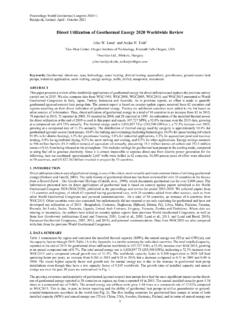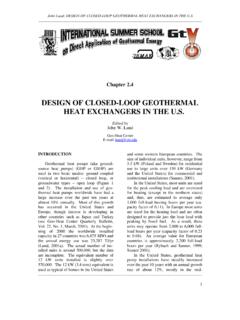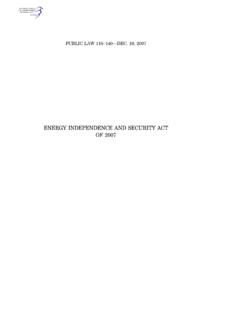Transcription of Geothermal Development in Djibouti Republic: A …
1 Proceedings of the 4th African Rift Geothermal Conference Nairobi, Kenya, 21-23 November 2012 Geothermal Development in Djibouti republic : A Country Report Aboulkader Khaireh and Fouad Aye Ministry of Energy, Water, and Natural Resources; Djibouti republic ABSTRACT Djibouti is a small country located in East Africa in the area where the Gulf of Aden meets with the Red Sea. It is therefore a strategic place between Africa and Arabia with neighbors like Ethiopia, Eritrea, Somalia and Yemen. For Ethiopia, Djibouti is presently the only access to the sea.
2 The port of Djibouti and the lines of communication such as roads, railways, electricity line between the two countries are developing very fast.( The current population of the Djibouti republic is estimated to be about 850 000, of which about 600 000 live in the main town of Djibouti -Ville, 95 000 in secondary towns and the remaining, 155 000, which includes a substantial nomadic population; in a rural The country s electrification rate is about 50%. Electricit de Djibouti (EdD), the national state-owned utility under Ministry of Energy and Water in charge of Natural Resources (MEERN), reports about 38 000 electricity connections for the Djibouti -Ville metropolitan area.)
3 Demand in Djibouti -Ville area is currently supplied from two main power stations Boulaos and Marabout. Boulaos has an installed capacity of MW and comprises 15 medium speed diesel generating units operating on heavy fuel oil. The older Marabout power station has an installed capacity of MW, with 6 medium speed diesel generating units operating on diesel oil and is used only in summer (demand peak). The Ethiopia- Djibouti interconnector became operational in May 2011 and provides an additional electricity source, based on renewable (hydro), ranging from 180 to 300 GWh per year.
4 It is therefore covering between half and two-thirds of the demand. The line terminates at a 220/63/20 kV substation, 12 km west of Djibouti -Ville, where the voltage is stepped down to 63 kV for interconnection with the existing transmission system. The transmission system is currently limited to a 63 kV inter-connector between the main stations, and two 20 kV transmission circuits from Djibouti -Ville to Arta, some 40 km away. There is also a 20 kV circuit between Dikhil and Ali Sabieh in the south of the country. The distribution system comprises 20 kV radial circuits emanating from the main substations.
5 Most customers are supplied at low voltage (LV) via distribution substations. Forecasts of future demand have been developed. In the base case, the peak annual demand is expected to increase from 75 MW in 2010 to 138 MW in 2015 and 219 MW in 2035. This provides an idea of a minimum target for Geothermal energy Development . 1. INTRODUCTION A Unique Geodynamic Context The position of Djibouti republic is unique in terms of geodynamics. It is located at the eastern extreme of the Afar triangle where two oceanic ridges (Gulf of Aden and Red Sea) meet with East African Rift. Owing to Djibouti s geodynamic context, a huge quantity of energy is dissipated from the very shallow earth mantle to the surface.
6 The Afar triangle and Iceland are the only two regions in the world where an oceanic ridge is accessible off shore for Geothermal exploitation. In contrast to Iceland however, the climate is rather arid, necessitating that Geothermal exploration pays attention to the Geothermal sites recharge The experience obtained from the Asal site, since the 1970 s, enables Djibouti to keenly consider the issue of hydrogeological parameters of the reservoirs - notably water recharge and quality. 2. Djibouti S Geothermal Development PROJECT Objectives The three main objectives of the Geothermal Development program of the Ministry in charge of energy are to: i.
7 Develop a site located in a favorable situation that responds to Djibouti -Ville s, present energy needs estimated 50 MWe ii. Explore the country s overall Geothermal resource potential to respond to the needs of other consumption centers and iii. Identify commercially exportable Geothermal reserves for future broader interest developments. The Project s Operations The existence of Djibouti s Geothermal resource has been known for 40 years. So far, there have been several unsuccessful efforts geared towards the resource s commercialization. Geothermal exploration therefore remains an important issue for the republic , in regards to self-dependency in electric power production and climate change mitigation.
8 The new Ministry of Energy, Water and Mineral Resources is in charge of this ambitious Development and works closely with its own team of professionals, . It now relies upon its own team, the Djibouti national scientific center (CERD), while benefiting from the assistance of various international of the 4th African Rift Geothermal Conference Nairobi, Kenya, 21-23 November 2012 Figure 1: Topographic and bathymetric base map of Djibouti republic with the . major tectonic features and Geothermal sites.
9 The penetration of the Aden Mid-Oceanic Ridge into the African continent is shown in the gulf of Tadjoura, with a progressive up-rise from East to West. The rift axis emerges in the Asal part of the Ghoubbet segment. Another active spreading segment is found North in Manda-Inakir, linked to Asal through the Makarassou (N-S) faulted zone. 3. HISTORY OF Geothermal EXPLORATION Djibouti s Geothermal exploration can be divided into two main historical phases: Phase one: Focused around an exploratory survey conducted by BRGM (France) in 1970 which showed several possible potential Geothermal areas from Lake Asal to Abhe Bad.
10 With the two initial drillings in the Asal rift in 1975, BRGM recognized a deep reservoir at 1100m depth with a high mineralization fluid (120g/l) at 260 c. Well Asal1 showed low production and was eventually plugged with sulphides scaling at the flash point in the well. Phase two: Centred around exploration of Hanle Gaggade area, in 1981 by Aquater (Italy), with the hope of finding less salty fluids away from the salt-saturated site of lake Asal. Two deep drillings in Hanle met only low temperature aquifers at depth; therefore the project continued to Asal rift with drillings of Asal3, Asal4, Asal5, and Asal6.















